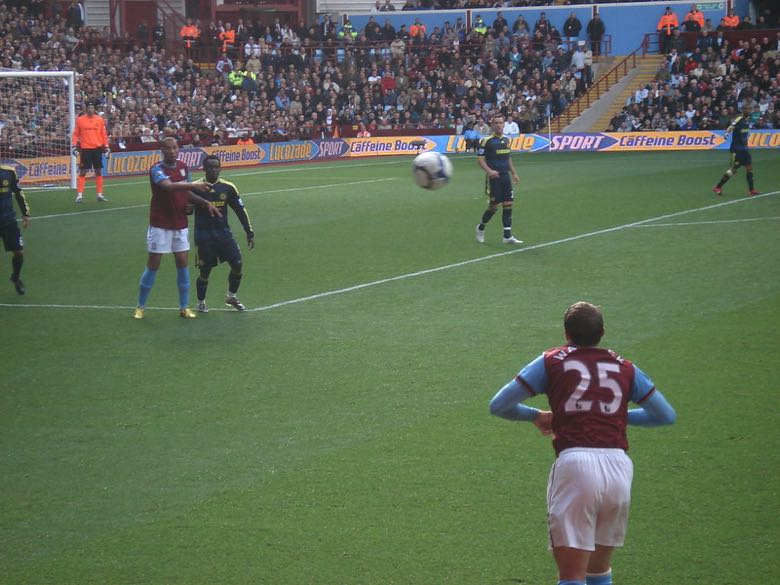Throw ins are one of the most frustrating ways to see a game of football restarted. The action of it itself is not frustrating, but watching a player from the opposing team walk 10 metres past the throw in mark is incredibly annoying, while no fan ever wants to watch a footballer wasting time by simply holding the ball above their head. Despite this, the throw in is an integral part of a game of football. In this guide to throw ins, we will look at what a throw in is, the rules and the history of throw ins in football.

bet365 6 SCORES CHALLENGE
Predict scores to win cash prizes!
Win cash prizes by predicting the scores of just six Soccer matches, with 6 Scores Challenge at bet365! All is not lost if you fall short on one or two results, prizes are on offer for three, four and five correct results.
The prize value displayed for six correct predictions is the maximum available based on a single winner in that round and will be reduced in the event of a shared prize-pool.
What Is a Throw In?
A throw in is a way of restarting a game of association football. A throw in will be awarded when the ball exits the side of the field of play. If the ball goes out of play by passing either goal line without going into the goal, then a corner or a goal-kick will be awarded, depending on who touched the ball last.
A throw in must be taken from the point at which the ball went out of play either on the ground or in the air. Usually, a referee will allow the player that is taking the throw in a small allowance when taking the throw. The throw in itself must be taken with the ball in both hands of the thrower, while the ball must come from behind the head too.
What Are the Rules of a Throw In?

The throw in must be taken from the point where the ball exits the side of the field. When the player throwing the ball is about to take the throw, they must face the field of play.
Positioning
The player must have some or all of both feet on or behind the touchline when they take the throw. The thrower also needs to ensure that they are using both hands to deliver the ball from over or behind their head. The ball will be deemed back in play as soon as it re-enters the field of play.
Goals Cannot be Scored Directly
It is worth noting that a goal cannot be scored at either ends directly from a throw in. If the attacking team throws the ball directly into the opposition’s goal without another player touching it, then a goal kick is awarded to the defending team. If a team throws the ball straight into their own goal without a player touching it, then they will concede a corner.
Offside Rule
One of the most important rules when it comes to throw ins is the offside rule. A player cannot be offside from a throw in. This means that an attacking player can run in behind the defensive line and receive the ball without being deemed to be offside. An opposing player must stay 2 metres from the thrower. If they fail to do this, then they can be given a caution (yellow card). Once the ball has been thrown, the thrower cannot touch the ball again until another player has touched it.
What Is a Foul Throw?
A foul throw is when a thrower fails to honour the rules of a throw in. A player will commit a foul throw if they:
- Cross the touchline with either of their feet
- Fail to keep both feet on the ground
- Fail to keep both hands on the ball when throwing it
- Are unable to get the ball to pass up and over their head when they throw it
- Cause the ball to bounce before it re-enters the field of play
If a foul throw is committed, then the opposing team will be awarded a throw in.
The History of Throw Ins

The FA laws of 1863 detailed that when a ball leaves the field of play, then it must re-enter the pitch by being kicked or thrown in by the person that first touched it down. However, when the final version of this ruling was adopted in December 1863, the option of a ‘kick-in’ was omitted. When the original throw in was added to the laws of the game, it had a number of difference to what we see today:
- Possession was awarded to the first player to get to the ball after it went out of play, rather than against the team that kicked it out.
- The ball had to be thrown perpendicular to the touchline, whereas in the modern game it can be thrown in any direction.
- The way the ball can be thrown was not specified, with the modern rules seeing the ball thrown from two hands from above the head.
Later on, the rules were merged with the Sheffield Football Association’s rules, with 1867 seeing a thrown in awarded against the team that kicked it out of play. By 1877, the throw in looked a lot more like the throw in we see today. However, there was still no restriction on how the ball had to be thrown back into play.
1882 saw the lack of a specific way to throw the ball finally decided. Scotland’s rules saw players having to throw the ball in with both hands on the ball that came from behind the head. England’s laws allowed players to throw it any way they chose. Scotland’s rules were adopted, with the FA formally introducing them in 1883.
Other rules have been tweaked across the history of the game, with the ability to score a goal or an own goal from a throw, being offside, the position of the thrower’s feet and the double touch rule all reviewed and updated. Ultimately, it has taken years to ‘perfect’ the thrown in, although it could still be cited that the current iteration of restarting a game when the ball goes out at the side of the pitch has its flaws.

